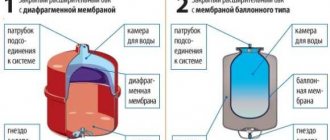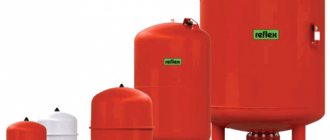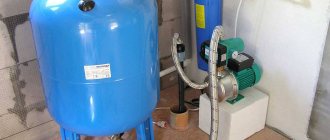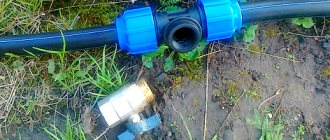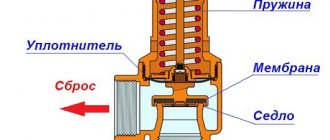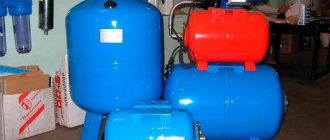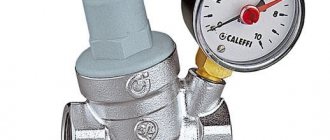Pressure in the hydraulic accumulator and expansion tank
Let the minimum permissible pressure in the system (heating - for the expansion tank, water supply - for the hydraulic accumulator, when the relay is activated and the pump turns on) be X atmospheres. Then the optimal pressure in the device in the absence of water in it (it is empty) should be 90% of X. You need to check the pressure by completely draining the water. Otherwise, measurements will not yield anything.
In general, air can gradually escape from hydraulic accumulators and expansion tanks. But regularly checking air sufficiency is difficult. To carry it out, you need to drain all the liquid from the device, which is not always possible. But there are signs that clearly indicate that the air has escaped. For a hydraulic accumulator, this means turning on the pump too often; for an expansion tank, there is a strong change in pressure in the system when the temperature of the coolant changes. Therefore, immediately after installing the tank, you need to measure by how many percent the pressure changes when the medium in the system is completely warmed up, write down this value, and then make sure that this value does not increase too much, pumping up as necessary. For a hydraulic accumulator, you need to measure the time between turning on the pump and turning it off, and also make sure that this time remains constant.
Malfunctions of the hydraulic accumulator for water supply systems, repair methods
If you are the owner of a country house or cottage that does not have a central water supply, then you can hardly overestimate the importance of a pumping station.
And there is nothing to be surprised here, because the presence of an autonomous water supply system will allow you to cope with a lot of everyday tasks.
Thanks to automation, which ensures the supply of the required volumes of life-giving moisture from a well or well, you can cook food, wash or take a bath, and water the area.
Malfunctions of the hydraulic accumulator lead to malfunction of the entire system
Any equipment, even one that is of good build quality and complies with advanced reliability and safety standards, can break down. This also applies to pumping stations – or more precisely, to their constituent elements.
One of these is a hydraulic accumulator - a device without which uninterrupted water supply to a private home or cottage is impossible. In this material we will tell you about common failures of hydraulic accumulators.
How can these devices be restored to their lost functionality?
Characteristics of the hydraulic accumulator
To begin with, let us list the main points due to which hydraulic accumulators are so significant - what the devices in question are needed for. First of all, they are necessary for the effective implementation of the following tasks:
- accumulation of a reserve supply of life-giving moisture, which can be used in case of an unforeseen situation;
- reliable protection of the pipeline from water hammer occurring as a result of turning on the pump;
- stabilization of excess pressure in the system;
- prolongation of uninterrupted operation of the pump (the pump mechanism is activated only when necessary);
- “equalization” of water pressure during intensive consumption;
- maintaining constant pressure in the pipes when the pump is turned off.
As for the design of the water supply device, it provides for the following elements:
Diagram of the hydraulic accumulator
- platform;
- housing made of durable stainless steel;
- membrane;
- flange with valve for water injection;
- air supply nipple.
As you can see, the hydraulic accumulator is not only extremely important, but also not the simplest device from a technical point of view.
It works a lot and intensively, and therefore one should not be surprised at the malfunctions that appear in it over time.
At the same time, its rapid failure is not the norm, since high-quality hydraulic accumulators, which are produced in accordance with current standards, have a solid service life.
Possible faults
It is worth talking about the problems that arise during the use of a hydraulic accumulator.
It should be immediately noted that if any kind of malfunction is detected in such an important element for water supply systems, they must be eliminated without delay.
You can do this either on your own or by involving professional performers - in accordance with the specifics of the situation.
“Turning a blind eye” to the incorrect operation of the device is highly discouraged: this can lead to failure of not only the hydraulic accumulator itself, but also other components of the system, and to additional financial expenses. What are the probable malfunctions and signs that indicate that the device needs urgent repair.
It is worth highlighting problems with the membrane, which are characterized by the following manifestations:
- the pump switching frequency is exceeded;
- water passes through the nipple;
- intermittent supply of life-giving moisture;
- liquid coming out from under the air valve.
The membrane is replaced after the tank is completely turned off
The solution here is prosaic: it consists of replacing the old membrane with a new one.
Please note that replacing the part occurs after disconnecting the tank from the system and completely draining the water in it.
When performing the above operations, take a close look at the drain valve: if air comes out of it, you can confidently determine that the membrane has been broken.
Common “symptoms” of a faulty accumulator include a constant drop in water pressure. There are two possible reasons for this misfortune, namely:
- nipple failure;
- missing or insufficient compressed air pressure in the tank.
Such problems can be eliminated and repairs can be made by replacing the nipple with a new one or by pumping up the pressure to the required level.
The process is directly related to the reason that caused the device to malfunction. Another sign of a faulty accumulator is water leaking from under the flange.
The repair here consists of tightening the fasteners; if it is impractical, then it is more rational to purchase a new flange.
There is a problem of low water pressure. Practice shows that this problem is a consequence of an incorrectly selected or incorrectly operating pump, and not a breakdown of the hydraulic accumulator.
In the first case, low pressure in the system is caused by a lack of power in the water supply equipment, and in the second - by its breakdowns of greater or lesser severity.
Whether to repair the pump yourself, it all depends on your skills and whether you have enough time and energy to solve such a problem. If you are not confident in your abilities, contact specialized specialists.
In conclusion, it remains to add that to reduce the likelihood of the hydraulic accumulator failing, pay attention to the prevention of the device.
At least once every six months, conduct a thorough inspection of the tank - checking it for damage and determining the degree of wear of the component parts of the device.
Do not forget to monitor the pressure level in the accumulator: this step helps to identify problems with the device at an early stage, making repairs simple and not requiring significant financial costs.
Source: https://vodospec.ru/nasos/neispravnosti-gidroakkumulyatora-dlya-sistem-vodosnabzheniya.html
Design differences
First of all, you need to understand that a hydraulic accumulator and an expansion tank, despite the assurances of some unscrupulous managers, are not the same thing. Their design differences are determined by the specific application. Installing an expansion tank as a hydraulic accumulator is fraught with unpleasant consequences.
The bottom line is that in the expansion tank for the heating system, the membrane divides the internal volume in half. Initially, air pumped into the lower half creates enough pressure for the membrane to be completely pressed against the inner surface. As the temperature of the coolant rises, its volume increases, the pressure increases and water begins to flow into the upper half, squeezing the membrane. Accordingly, the air in the lower half is compressed. The hydraulic accumulator is distinguished by the fact that it contains a balloon membrane, entering which water does not come into contact with the internal walls.
Closed expansion tanks: with diaphragm membrane, with balloon membrane
When considering the differences between an expansion tank and a hydraulic accumulator, it is necessary to understand that they operate under different conditions. The change in the volume of liquid in the heating system is insignificant; moreover, it happens slowly, without sudden jerks. However, temperatures can reach 90 °C. Therefore, the first requirement for such a membrane is resistance to prolonged exposure to high temperatures.
For a balloon membrane in a cold water accumulator, resistance to high temperatures is not so important, but the ability to operate in frequent expansion/compression mode is key
Unfortunately, there is no universal material that is equally resistant to high temperatures and regular stretching. The membranes in modern expansion tanks are made of the following materials:
— NATURAL — can be used at operating temperatures from -10 to 50 °C. Extremely elastic material, but partial diffusion may occur with use. Natural rubber can be used for both drinking and industrial water;—BUTYL—can be used at temperatures from -10 to 100 °C. More stable in terms of diffusion, but not as elastic as NATURAL. Synthetic butyl rubber can be used as a hydraulic accumulator membrane; - EPDM - operates at temperatures from -10 to 100 °C. More permeable to water than BUTYL. Synthetic ethylene/propylene rubber is installed in tanks for drinking or process water;— SBR – operation at temperatures from -10 to 100 °C is permissible. Less elastic. Used exclusively in expansion tanks of the heating system, not elastic enough for installation in hydraulic accumulators; - NITRIL - works at temperatures from -10 to 100 ° C. Resistant to active media.
The scope of application of compensation tanks is not limited to heating systems and water supply; they are successfully used for storing fire extinguishing liquid in automatic fire extinguishing systems, as well as as part of a powder fire extinguishing module.
Regardless of the type, the hydraulic accumulator and expansion tank are an integral part of any life support system and provide a high level of comfort and safety of living.
Selecting a hydraulic accumulator, expansion tank. Service. Exploitation. Repair. (10+)
Hydraulic accumulator, expansion tank. Features of choice
The hydraulic accumulator and expansion tank are designed for slightly different purposes, but are designed almost identically, so I combined them in one article. The hydraulic accumulator is designed to accumulate water in an autonomous water supply system, protect the system from excess pressure, and prevent frequent activation of the pump. The expansion tank is installed in the heating system. It protects it from excess pressure, which can occur when water (or other coolant) expands due to increased temperature. The key difference between a hydraulic accumulator and an expansion tank is that the expansion tank must operate at a sufficient temperature; such requirements are not imposed on a cold water accumulator. But for most hydraulic accumulators there are high requirements for the quality of the membrane material, since they are used to supply water that can be used for food. For an expansion tank, such requirements are less critical.
Expansion tank and hydraulic accumulator. Malfunctions. Ways to eliminate them.
So, a membrane expansion tank (hydraulic accumulator, hydraulic tank, expansomat) is a companion to all pumping water supply systems, hot water supply systems, heating systems, solar systems, in general, all systems in our house in which thermal expansion of the liquid occurs or there is a need to reduce the number of starts pump Naturally, the reliability and durability of each node in the engineering systems and communications of our houses is limited and decreases over time. The Murphy-Chisholm Law, dedicated to aeronautics and communication systems in our home, states - “Anything that can break, breaks. Everything that can never break, breaks too
" Expansion tanks and hydraulic accumulators are no exception to this rule.
Let's consider ways to determine the malfunction of expansion tanks in relation to three main areas of their application - a hydraulic accumulator in a cold water supply circuit, a multifunctional tank in a hot water supply circuit and an expansion tank in a heating circuit.
Picture 1 . Design of expansion tanks with replaceable membrane and fixed diaphragm.
1. Hydraulic accumulator in the water supply system of the house.
Visual signs of a faulty accumulator:
- the pressure gauge shows an abrupt change in pressure - the pressure gauge needle sharply deviates upward and sharply drops to zero.
Design and purpose of devices
Expansion tank
- The main purpose of the tank is to compensate for the expansion of the coolant. When heated, water increases in volume, and quite strongly (+0.3% for every 10 degrees Celsius). In this case, the liquid practically does not compress, so the heated coolant will exert significant pressure on the walls of the pipes, joints and shut-off valves.
- To compensate for this pressure, as well as to minimize the consequences of water hammer, an additional reservoir is built into the system - an expansion tank. The first tanks were of a leaky design, but today pneumatic-hydraulic models are almost universally used.
- Inside such a tank there is a membrane made of elastic material. Since the membrane is in contact with a heated coolant, it is made from polymers that are resistant to high temperatures - EPDM, SBR, butyl rubber and nitrile rubber.
- The membrane divides the tank into two cavities - the working cavity (the coolant enters it) and the air cavity. As the pressure in the system increases, the air chamber decreases in volume (due to air compression), and this compensates for the load on the pipes and shut-off valves. Approximately the same thing happens with water hammer - but here the process occurs at a faster speed.
- As the temperature of the coolant decreases, the volume of water decreases, and the air, exerting pressure on the membrane, displaces an additional volume of hot water into the pipes of the heating system.
Hydraulic accumulator
The hydraulic accumulator, at first glance, is practically no different in design from the expansion tank:
- The base is the same container made of corrosion-resistant steel, only painted blue.
- There is also a membrane inside the container - although it is slightly different in shape from the membrane of the expansion tank.
- The internal volume is also divided into two chambers, only in hydraulic accumulators the water chamber is located inside the membrane, i.e. Contact of the liquid with the metal walls of the tank is completely eliminated.
And the design functions on a similar principle, although it is used for a different purpose:
- When the pump is turned on or water is supplied through a centralized water supply, the chamber is filled with liquid under a certain pressure.
- If the pressure drops for some reason, the air chamber increases in volume and water from the working chamber enters the system. Thanks to this, the pressure in the pipes is stabilized, and the equipment (washing machines, dishwashers, etc.) works without failures.
- The second aspect of the operation of the hydraulic accumulator is protecting the pump from frequent starts. While it is possible to compensate for the withdrawal of water from the system due to the reserve in the tank, the pressure switch will not operate and the pump will not start pumping water. Thus, the equipment will turn on less often, which means it will work longer.
- A large hydraulic accumulator (50, 100 or more liters) is also a water supply. Yes, you won’t last long on such a supply, but if you use it sparingly, you can easily survive a water supply accident or a power outage that will make the pump impossible to operate.
- In addition, the hydraulic accumulator, like the expansion tank, compensates for water hammer.
Required volume of hydraulic accumulator and expansion tank
You need to clearly understand that the volume of these devices, which is given in the specification, is the volume of the tank itself. Less liquid can be placed in it. The volume of liquid depends on pressure.
Determining the volume of the expansion tank is quite simple. You need to understand how much water (or antifreeze) will be in your heating system. Let us take the coefficient of thermal volumetric expansion of water with a margin of 6E-4. Thus, the volume of water when heated from zero to 100 degrees will increase by 0.06 times, that is, by 6%. If there are 100 liters of water in the system, then the excess volume will be 6 liters.
Now we need to decide on the permissible coolant pressure in the heating system. Let the minimum value be X1 and the maximum value X2. Usually it is 1.8 atmospheres and 2.4 atmospheres. If the pressure in an empty expansion tank is 90% of the minimum permissible for the coolant (let it be X0), then [ Required volume of the expansion tank, liters
] = [
0.06
] * [
Coolant volume in the system, liters
] / (([
X0, liters
] + [
1
]) / ([
X1, liters
] + [
1
]) — ([
X0, liters
] + [
1
] ) / ([
X2, liters
] + [
1
])). For our case with 100 liters of media, we get 36 liters. In this case, more is not less. You can take it with a reserve, but even this volume will be enough.
The volume of the accumulator depends solely on the maximum peak water flow. If one tap can operate in a house at the same time, then the volume of the accumulator should be about 30 liters, if there are two taps - 60 liters, if 3 - 90, and so on.
Expansion tanks, hydraulic accumulators, for heating and water supply systems
Closed expansion tanks and hydraulic accumulators have approximately the same design: a durable metal shell, divided inside by a rubber membrane into two sections.
One section contains water, the other contains air. As water pressure increases, the air is compressed, the size of the section with air decreases, and the membrane bends, water displaces the air. The device has a connection to the water supply system on one side, and a spool valve for pumping air on the other.
But devices are named not because of their design features, but according to their intended purpose.
Purpose
- Expansion tanks are designed to compensate for the expansion of water due to heating in heating circuits, as well as hot water supply (DHW).
- Hydraulic accumulators are designed to accumulate volumes of water under pressure in water supply systems that have a pressure pump, to reduce the frequency of switching on of this pump and to smooth out water hammer. An additional function is a supply of food-grade water up to 1/3 of the total tank volume.
The nuance is that the same device is used for both hot and cold water supply, but it can be called differently, depending on what it does in a particular circuit - it either accumulates (accumulates) a supply of water, or takes its excess during thermal expansion.
- The design feature of the hydraulic accumulator is often that inside there is not a membrane, but a bulb made of food-grade rubber, which is pumped with water. Water does not come into contact with the tank body.
- The expansion tank for the heating system is made of a membrane made of technical rubber, which divides the housing into two compartments, and the coolant (not always water) is in direct contact with the housing.
How to differentiate
In appearance, all membrane tanks are similar to each other. There is an opinion that for the heating system - red, and for water supply - blue. But it is not entirely true, since some manufacturers use other colors.
In fact, devices can be distinguished from each other only by technical characteristics, which are indicated on the nameplates on the devices themselves:
- All devices for water supply, including for hot water supply - low temperature - up to 80 degrees C, but high pressure - up to 12 Atm;
- expansion tanks for heating - high temperature - up to 120 degrees C, but low pressure up to 4 Atm.
How water storage schemes work
The hydraulic accumulator in the water supply circuit smoothes out pressure surges that occur when water is drawn from the system, i.e. when opening the tap, and reduce the number of pump starts, which should not be more than 50 times per hour.
When water is taken in the volume of a cup, the hydraulic accumulator will release this volume, the pressure in the system will drop, but not so much that the pressure switch turns on the pump.
When taking a larger volume (for example, the volume of a bucket), the pressure will drop so much that the pump will turn on and fill the device.
The expansion tank in hot water supply and heating systems receives the excess volume of water that arises when it is heated.
If there were no such device, then in a heating closed circuit the pressure would very quickly rise above the critical one, since the liquid is practically not compressed. This would result in the release of water from the emergency pressure valve, which is usually set to a pressure of 3 atm.
In practice, if such a valve constantly lets water through, this indicates a malfunction of the storage device. If there is no emergency valve, then when heated, the weakest point of the system will be destroyed.
When an expansion tank is needed in a hot water supply system
This is a natural question, because hot water supply can be done in different ways. If there is a flow-through heater, for example a gas double-circuit boiler, which heats a stream of water directly when it is drawn in, then naturally an expansion tank is not needed.
If the system heats water in a large-capacity closed boiler (more than 100 liters), then the installation of an expansion tank in addition to a safety valve is required. Which is not the right thing to hope for, since it is not at all designed for frequent operation and with frequent activation it simply begins to leak.
How to choose the volume of a heating device
The main question that arises for the user is how much volume of such a water storage device is needed? At the same time, the user wants to purchase a smaller volume, since it is cheaper. But you need to purchase the one that suits your calculations.
The volume of the expansion tank for heating will depend on the volume of coolant in the system, the maximum and set pressures. The formula for calculating the volume is shown in the photo:
The volume of coolant is indicated in the design data, or it can be calculated by adding up all the internal volumes of the system elements; finally, in the finished system it can be calculated when pouring it into buckets.
Source: https://teplodom1.ru/sistemotopl/122-rasshiritelnye-baki-gidroakkumulyatory-dlya-sistem-otopleniya-i-vodosnabzheniya.html
Connecting the accumulator to the system
Typically, the water supply system of a private home consists of:
- pump;
- hydraulic accumulator;
- pressure switch;
- check valve.
This scheme may also include a pressure gauge for operational pressure control, but this device is not necessary. It can be connected periodically to carry out test measurements.
With or without five-pin fitting
If the pump is of a surface type, the hydraulic accumulator is usually placed next to it. In this case, the check valve is installed on the suction pipeline, and all other devices are installed in one bundle. They are usually connected using a five-pin fitting.
It has terminals with different diameters, just for the devices used for tying the hydraulic accumulator. That’s why the system is most often assembled on its basis. But this element is not at all necessary and everything can be connected using ordinary fittings and pieces of pipe, but this is a more labor-intensive task, and there will be more connections.
With one inch outlet, the fitting is screwed onto the tank - the pipe is located at the bottom. A pressure switch and pressure gauge are connected to the 1/4 inch outlets. The remaining free inch terminals are connected to the pipe from the pump and wiring to consumers. That's all for connecting the gyroaccumulator to the pump. If you are assembling a water supply circuit with a surface pump, you can use a flexible hose in a metal winding (with inch fittings) - it is easier to work with.
As usual, there are several options, the choice is yours.
The hydraulic accumulator is connected to the submersible pump in the same way. The whole difference is where the pump is installed and where the power is supplied, but this has nothing to do with the installation of the accumulator. It is placed in the place where the pipes from the pump enter. Connection is one to one (see diagram).
How to install two hydraulic tanks on one pump
When operating the system, sometimes owners come to the conclusion that the available volume of the accumulator is not enough for them. In this case, you can install a second (third, fourth, etc.) hydraulic tank of any volume in parallel.
There is no need to reconfigure the system; the relay will monitor the pressure in the tank on which it is installed, and the viability of such a system is much higher. After all, if the first accumulator is damaged, the second one will work. There is another positive point - two tanks of 50 liters each cost less than one of 100. The point is that the technology for producing large-sized containers is more complex. So it is also more economical.
How to connect a second accumulator to the system? Screw a tee onto the input of the first one, connect the input from the pump (five-pin fitting) to one free output, and connect the second container to the remaining free one. All. You can test the circuit.
Do-it-yourself hydraulic accumulator repair: step-by-step instructions
The design of a water supply system for a private home includes many important elements. And you can’t call it simple. One of its most important elements is the hydraulic accumulator.
This device is responsible for maintaining constant pressure in the system and also protects the water supply from water hammer. However, nothing lasts forever, therefore, sometimes it is necessary to repair the hydraulic accumulator. At the same time, most faults can be fixed with your own hands.
Main malfunctions of hydraulic tanks
In fact, the design of a hydraulic accumulator is not particularly complicated. It consists of:
- main tank;
- membrane or rubber cylinder for storing water;
- pressure switch, pressure gauge and other fittings.
However, despite their simplicity, these devices can break. The main malfunctions of the hydraulic accumulator for private water supply systems:
- turning the pump on and off too often. This can be caused by various reasons. The most common are a decrease in air pressure in the tank, damage to the membrane and damage to the tank body. In addition, the pressure switch may be incorrectly configured;
- air pressure is below normal - most likely the nipple is damaged and does not hold pressure;
- water leaks from the air valve - this indicates damage to the membrane;
- The required water pressure does not build up - there is not enough air in the tank.
Of course, the best option is to call a specialist or send the hydraulic tank to a service center for repairs. However, if you wish, you can do the repairs yourself.
Replacing the membrane
Quite often, it is necessary to change the membrane in the accumulator. However, before disassembling the tank, you should make sure that the reason is in the membrane. After all, the issue could be an incorrect setting of the pressure switch, or a small volume of air in the hydraulic tank.
One of the common problems is membrane failure
The main signs by which membrane damage can be determined:
- turning on the pump too frequently;
- Water is leaking from the nipple and air valve.
In this case, membrane repair is done in the following sequence:
- first of all, you need to purchase a new pear and prepare a set of keys;
- after this, the accumulator is disconnected from the water supply system;
- water is drained from it and air is released;
- now you need to unscrew the flange and remove the old bulb;
- further, it is advisable to carefully examine the inside of the tank - if there is dirt or rust, then you need to clean it;
- after this, the new membrane is straightened and installed in its seat;
- then, it is pressed against the flange.
Now, you need to pump the hydraulic accumulator into its operating pressure, usually 1.5-2 atmospheres. And then do a test run. At the same time, water must be supplied to the new bulb under low pressure - this will eliminate the possibility of damage. You can read more about the nuances of repair in the article “How to replace the membrane in a hydraulic accumulator.”
Blood pressure problems
This problem can be caused by a number of reasons:
- damage to the nipple - air escapes through it;
- incorrect setting of the pressure switch;
- damage to the tank body.
Sequence of actions for repair:
- First, you should check the integrity of the housing itself - if it is rotten, then the hydraulic accumulator may need to be replaced;
- If everything is in order with the housing, it is worth checking the operation of the pressure switch. It is quite possible that his settings have gone wrong;
- for this, it is worth trying different operating modes for the hydraulic tank - if the relay works, then you need to look for the cause elsewhere;
- Now you need to check the nipple - it may be bleeding air, if so, then the repair will come down to replacing it.
The pressure gauge may show incorrect values
Another reason is a malfunction of the pressure gauge. Those. it may show incorrect numbers. This point is also worth considering.
Pump starts too often
This phenomenon indicates a lack of air pressure in the tank for water supply systems. Therefore, the very first thing to do is check the pressure gauge readings.
Here you need to take into account the fact that this device may show incorrect values. Therefore, you can simply completely bleed the system through the air injection valve and re-inflate it. If the pressure gauge is faulty, you need to replace it.
Another possible reason is that the pressure control relay has gone astray. In this case, you need to adjust it. It is possible that the problem will be resolved.
A broken pressure switch is also one of the possible faults.
You also need to inspect the hydraulic accumulator itself - if the integrity of the housing is damaged, the air will be released. Depending on the size of the damage, you will either need to seal it or buy a new one.
Another common reason is that the air nipple has failed. If so, then it just needs to be changed. To do this, you need to disconnect the hydraulic accumulator from the water supply system and bleed the air from it. After this, you need to unscrew the old nipple and insert the new one in place.
Then air is pumped into the tank to 1.5 atmospheres, and then water is drawn into the membrane.
Water comes out from under the flange
Sometimes such a breakdown happens. However, it is easy to treat - usually just tighten the nuts on the flange. If this does not help, then you will have to drain the water from the tank and relieve the air pressure, and then remove the flange.
Repair
Common malfunctions are: breakdown of the air check valve (nipple) and damage to the membrane. The check valve can be replaced by installing it from a car tire. They fit most hydraulic accumulators and tanks. Damage to the membrane can only be repaired in repairable (dismountable) devices. I've done this myself successfully a couple of times. You need to disassemble the tank, remove the membrane, wash and dry it thoroughly, find the place of damage, degrease, seal or vulcanize it
When choosing an adhesive, be sure to pay attention to whether it is waterproof, elastic, whether it can be used for elevated temperatures (for an expansion tank), whether it can come into contact with food (for a hydraulic accumulator)
Unfortunately, errors are periodically found in articles; they are corrected, articles are supplemented, developed, and new ones are prepared. Subscribe to the news to stay informed.
My question is: is it possible to use a container with one input as a hydraulic accumulator? Will water compress the air inside the container and thereby act as a damper? What I mean is that there is no membrane in the design. Read the answer.
Heating system with forced circulation. Organization of forced circulation of coolant in the circuits of the heating system.
Fill in coolant. How to replace antifreeze in the heating system. How to properly fill the heating system with coolant, choose between water and.
Pipe heating system to prevent winter water supply from freezing. With your own hand. DIY plumbing. External, non-freezing. Laying water pipes h.
Gas to the house is autonomous. Is this real? Personal experience. Review. Installation errors. Review of experience in autonomous gasification, installation of a gas holder for liquefied gas. T.
Sealed threaded pipe connection. Plumbing glue - sealant. How to properly thread pipes in a pipeline? Ensuring tightness.
Personal experience in selecting a gas burner for heating according to its characteristics. How to choose the right gas burner for heating. Adviсe. Personal experience. Review.
To prevent the pump from turning on every time a faucet is opened in the house, a hydraulic accumulator is installed in the system. It contains a certain volume of water, sufficient for a small flow rate. This allows you to practically get rid of short-term pump starts. Installing a hydraulic accumulator is not difficult, but you will need a few more devices - at least a pressure switch, and it is also desirable to have a pressure gauge and an air vent.
Hydraulic accumulator maintenance
It is necessary to regularly check the equipment parts and change them in a timely manner.
In order for the plumbing system to work taking into account the responsibilities assigned to it, it is necessary to properly maintain it. In this regard, special attention is paid to the hydraulic tank. Preventive actions:
- once every six months, check the nitrogen pressure inside the container for compliance;
- check the membrane tightness once a year;
- once a month inspect the tank for dents, rust and other external defects;
- Once every six months, check the operation of the pressure switch: whether the pump turns on and off correctly, whether it corresponds to the specified parameters.
If the house is being preserved for the winter, the water supply must be prepared. The owner’s main task is to drain the water from the accumulator and pipes. In the spring, it is recommended to check all elements. The gas pressure in the hydraulic tank is first checked, and then it is filled and checked for leaks.
What should be the pressure in the accumulator?
One part of the accumulator contains compressed air, and water is pumped into the second. The air in the tank is under pressure - factory settings - 1.5 atm. This pressure does not depend on the volume - it is the same on a tank with a capacity of 24 liters and 150 liters. The maximum permissible maximum pressure may be more or less, but it does not depend on the volume, but on the membrane and is indicated in the technical specifications.
Preliminary check and pressure correction
Before connecting the accumulator to the system, it is advisable to check the pressure in it. The settings of the pressure switch depend on this indicator, and during transportation and storage the pressure could drop, so monitoring is very desirable. You can control the pressure in the hover tank using a pressure gauge connected to a special input in the upper part of the tank (capacity of 100 liters or more) or installed in its lower part as one of the piping parts. Temporarily, for control, you can connect a car pressure gauge. Its error is usually small and it is convenient to work with. If this is not the case, you can use the standard one for water pipes, but they are usually not very accurate.
If necessary, the pressure in the accumulator can be increased or decreased. There is a nipple at the top of the tank for this purpose. A car or bicycle pump is connected through the nipple and the pressure is increased if necessary. If it needs to be vented, the nipple valve is bent with some thin object, releasing the air.
What air pressure should be
So should the pressure in the accumulator be the same? For normal operation of household appliances, a pressure of 1.4-2.8 atm is required. To prevent the tank membrane from tearing, the pressure in the system should be slightly higher than the pressure of the tank - by 0.1-0.2 atm. If the pressure in the tank is 1.5 atm, then the pressure in the system should not be lower than 1.6 atm. This value is set on the water pressure switch, which works in tandem with the hydraulic accumulator. These are the optimal settings for a small one-story house.
If the house is two-story, you will have to increase the pressure. There is a formula for calculating the pressure in the hydraulic tank:
Vatm.=(Hmax+6)/10
Where Hmax is the height of the highest point of water intake. Most often this is a shower. You measure (calculate) at what height relative to the hydraulic accumulator its watering can is located, substitute it into the formula, and get the pressure that should be in the tank.
If the house has a jacuzzi, everything is more complicated. You will have to select it empirically - changing the relay settings and observing the operation of water points and household appliances. But at the same time, the operating pressure should not be greater than the maximum permissible for other household appliances and plumbing fixtures (indicated in the technical specifications).
Maintenance Rules
The optimal feature of the hydraulic accumulator ensures constant water pressure and prevents wear of system parts.
Like all plumbing fixtures, the hydraulic accumulator has a certain service life. To increase it, it is necessary to carry out periodic maintenance. If the pumping unit turns on and off more frequently, this indicates that the pressure inside the tank has decreased - an air leak has occurred.
How to adjust air pressure
You can deal with the reason for the frequent activation of the accumulator with your own hands. To do this, you need a pressure gauge, which measures the pressure in car wheels. Sequence of operations:
- the pump is disconnected from the power supply network;
- any tap or mixer in the water supply network opens to relieve water pressure;
- remove the protective nipple cover, which is located on the opposite side of the inlet pipe;
- a pressure gauge is connected to the nipple;
- The air pressure reading is taken; it must correspond to the parameter specified in the product passport or on the metal plate located on the accumulator body.
If the pressure is much lower than the rated pressure or there is no pressure at all, air is pumped into the tank using a conventional car pump or compressor.
Before downloading, you must open one of the consumers. The one closest to the hydraulic accumulator is better. It is impossible to pump air into a tank that is almost completely filled with a bulb filled with water.
It is very important to adjust the air pressure correctly. If this parameter is higher than the passport value, a situation may arise when the air compresses the membrane to the maximum, causing it to shrink. It will be impossible to pump water into it. Therefore, after pumping, you need to check the pressure with a pressure gauge. If the indicator is higher than required, it is necessary to bleed the air.
In factory conditions, the hydraulic accumulator is usually filled with nitrogen. This does not mean that gas cannot be replaced with air. You just need to release it first.
The hydraulic accumulator must be checked for functionality once every six months. If the pressure in it drops, then there is a problem in the joint between the body and the nipple. Solving this problem is also easy. It is necessary to tighten the nipple or bolts on the flange. Leak testing is usually done using a soap solution.
Hydraulic accumulator service life
Hydraulic accumulator design
There are recommendations from manufacturers that must be used during the operation of hydraulic accumulators. If you strictly adhere to them, you can almost double the service life of the device.
- Once a month, check for compliance with the set value for turning on and off the pumping unit.
- Once every six months, inspect the hydraulic accumulator for external condition: the presence or absence of dents, corrosion, leaks, etc.
- Check the air pressure with a pressure gauge once every six months.
- If the country house will not be used in cold weather, care must be taken to drain the water from the accumulator for the winter.
The hydraulic tank is available on the market in two versions: horizontal and vertical. Regardless of this, the maintenance is the same.
How to choose
The main working body of the hydraulic tank is the membrane. Its service life depends on the quality of the material. The best membranes today are made from isobutated rubber (also called food grade). The body material only matters in membrane-type tanks. In those in which a “pear” is installed, water comes into contact only with rubber and the material of the body does not matter.
What's really important about bulb tanks is the flange. It is usually made of galvanized metal
In this case, the thickness of the metal is important. If it is only 1 mm, after about a year and a half of operation, a hole will appear in the metal of the flange, the tank will lose its tightness and the system will stop working. Moreover, the warranty is only one year, although the stated service life is 10-15 years. The flange usually deteriorates after the warranty period expires. There is no way to weld it - the metal is very thin. You have to look for a new flange at service centers or buy a new tank.
So, if you want the accumulator to last a long time, look for a flange made of thick galvanized or thin, but made of stainless steel.
Membrane for a hydraulic accumulator: how to replace it if it malfunctions
The normal functionality of the home water supply system depends on the health of the accumulator.
If there are malfunctions in the water supply network, it is necessary to immediately determine the cause of the malfunction and repair the equipment.
Otherwise, more serious breakdowns and irreversible failure of all equipment may occur. The most common cause of failure is the accumulator membrane. We will find out how to check it, replace it and diagnose the system.
How to check and diagnose faults
Most hydraulic accumulator malfunctions can be corrected independently. All reasons can be divided into several groups.
Table 1. Malfunctions in hydraulic accumulators
| Signs | Possible cause of malfunction | Diagnostics | Remedy |
| Pump malfunctions - frequent on/off | Membrane failure | Disconnect the hydraulic accumulator from the system: Start draining the water. If air escapes, the membrane has mechanical damage. | Replacing a damaged unit with a new one |
| Leak behind the air valve | |||
| Intermittent streams from the faucet | |||
| Liquid leaking from nipple | |||
| Low system pressure | Nipple failure; lack of compressed air in the tank. | Replacing the nipple; Pumping air to the required pressure | |
| Leaking from under the flange | Depressurization of the connection | Tighten the fasteners or replace the part with a new one | |
| Weak water pressure | Pump fault | Install a pump of the required power, replace the faulty one with a working one | |
| Incorrect hydraulic tank volume selected | Make a calculation and replace the equipment with a suitable one |
Recommendations for servicing hydraulic accumulators:
- Monthly inspection, checking that operating parameters comply with the standard (for each model and system individually).
- Check for corrosion stains on the body and connections.
- Check for leaks and surface moisture at joints.
- If there are malfunctions or malfunctions, correct them immediately.
- Checking the integrity of the membrane (inspection every six months).
- When not in use, store the hydraulic tank in a dry place, avoid contact with heating devices (to avoid drying out and destruction of the membrane material).
Diagram of the hydraulic accumulator
How to check the initial pressure in a container:
- Disconnect the tank from the system.
- Drain the water.
- Connect the pressure gauge to the nipple.
- If the readings are lower than the default ones, it is necessary to pump up the pressure to working pressure (with a car compressor, for example).
Membrane selection
Hydraulic accumulators are available in vertical and horizontal versions. Accordingly, membranes are also distinguished in various shapes and designs: cone-shaped, cylindrical, spherical, ribbed.
When replacing a unit, you should purchase a product with similar characteristics - size, volume, neck diameter, maximum temperature of the working environment, material, operating pressure, etc.
Replacement cost
The membrane is the element of equipment that most often fails, because... is subjected to constant compression and stretching. The cost of replacement depends on the type of tank, capacity, type of membrane, manufacturer.
If the water supply system is operated continuously, it is advisable to purchase a more expensive membrane that can withstand a greater number of operating cycles.
The cost of models from imported manufacturers reaches half the cost of the hydraulic accumulator itself. At the same time, the nominal service life of products is several times higher than cheaper ones.
Repair or how to seal
The membrane can be repaired by vulcanization. This method can extend its service life by several weeks until a working product is purchased and installed. But any repairs are a temporary measure and in any case you will have to buy a new one.
Diagram of hydraulic accumulator elements
Expansion tank
Heating water is designed to transfer heat from the boiler to the radiators. It is known that when heated by 10 °C, the volume of water increases by approximately 0.3%, from which it follows that heating to the required 70 °C will increase the volume by approximately 3% from the original. It is known from a school physics course that liquids are practically incompressible, therefore even such a seemingly insignificant increase in volume can lead to rupture of the pipeline or leaks at the joints. In order to prevent this, an expansion tank is installed in the heating system.
Initially, such containers were open, which led to certain problems:
— the liquid in them constantly evaporates, you have to monitor the water level and replenish it regularly;— an open expansion tank must be installed in the upper part of the system and insulated to prevent freezing of the coolant and, as a consequence, an increase in the cost of the structure;— constant access of oxygen promotes corrosion;— Pressure regulation with an open circuit is difficult.
Modern materials and, in particular, durable and elastic membrane material, make it possible to set up a closed system, without access of oxygen to the coolant. This also allows for a constant water level and the ability to adjust the pressure. Another advantage of a closed container is that it is easy to install and maintain. It can be installed at any point in the heating system and, if necessary, easily dismantled and connected elsewhere.
Hydraulic accumulator and preventive measures
It is necessary to find out possible malfunctions of the hydraulic accumulator in advance, since in this case you can relatively quickly find the source of the problem, and then replace or repair the element.
However, it is better to devote time to regular maintenance of the device, which works daily and tirelessly. A visual inspection, during which you can easily find leaks and detect “extra” pressure, is recommended to be done monthly or once every 2 months. It is recommended to inspect the storage tank once every six months, at least.
It consists of checking the tank for damage and determining the degree of wear of all its elements. Constantly monitoring the pressure level inside the accumulator is a measure that will help detect problems at an early stage. In this case, a serious malfunction will be easier to prevent, and simple repairs will not require large expenses.
“Elderly” models that have worked for their owners for at least 3 years require comprehensive preventive measures. Such devices are disconnected from the system, and the membrane is replaced even if it is “seemingly intact.” If the owners are not satisfied with the condition of other parts, they are advised to replace the flange and nipple at the same time. Manufacturers strongly recommend purchasing only “original” products. This is especially true for pears.
Fortunately, this equipment is quite simple, so possible malfunctions of the hydraulic accumulator can be counted on one hand, and in most cases it is not difficult for the owners to fix them. In order to encounter troubles as little as possible, it is better to handle the container carefully and maintain it regularly. With such a caring attitude, the chance of trouble-free operation of the membrane tank increases significantly.
Prices for water batteries can be found here:
You can learn how to get rid of one of the common problems of GA from the following video:
Was this article helpful? We want to improve. Thanks for your opinion!
